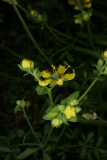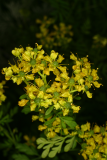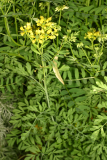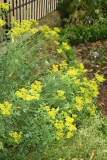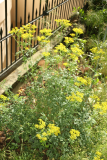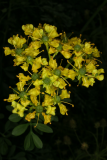Additional notes (click to expand)
Medicinal
Traditional Herbal Medicine Registration (THMR).
Culpeper: ‘Rue seeds help such as cannot hold their water.’
Culpeper, Nicholas. (1650). A Physical Directory . London, Peter Cole.
Nomenclature
Other common names: Herb of Grace; Ave Grace; Bitter Herb; Countryman's Treacle; Herb Grace; Herb Impia; Herb of Repentance; Ruth; Serving Man's Joy.
Other use
It is used to give a pleasant aroma to grappa, the Italian drink made from the dregs of grapes, and was used, as a tea, to induce abortions (Dioscorides, Pliny, Celsus and others). The famous mithridate, the antidote to all poisons, named after King Mithridates, was a mixture of rue leaves, walnuts, figs and a pinch of salt (Jashemski).
Oakeley, Dr. H. F. (2013). The Gardens of the Pharmacopoeia Londinensis.
Phytochemistry
It contains a chemical, rutin, that has vasopressor activity.
Oakeley, Dr. H. F. (2013). The Gardens of the Pharmacopoeia Londinensis.
Toxicity
Rue is best known now for causing a severe photosensitivity reaction on skin contact with the leaves, to the extent or causing painful blistering and scarring.
Oakeley, Dr. H. F. (2013). The Gardens of the Pharmacopoeia Londinensis.
All parts of the plant contain "bergapten, psoralen, (fura-nocoumarins), kokusa-genine, skimmianine, rutamine, dictamine (quinoline alkaloids). Highly to moderately hazardous (Class 1b - II). These are furanocoumarins and alkaloids, intercalate and alkylate DNA, strong skin irritant, blister formation, itching, internally: salivation, gastroenteritis, irritation of GI tract, narcotic, abortifacient, haematuria, visual distortions.
Wink, M. (2009). Mode of Action and toxicology of plant toxins and poisonous plants. Mitt. Julius Kuhn-Inst. 421:93-111.
Toxicity due do sesquiterpene lactones and furanocoumarins.
Professor Anthony Dayan, 2021
Humans/Pets: TOXIC to skin with sunlight. HTA guidelines
HTA Guide to Potentially Harmful Plants, 3rd Edition (2022)
Geographical distribution
- Europe, Eastern Europe, Ukraine
- Europe, Southeastern Europe, Albania
- Europe, Southeastern Europe, Bulgaria
- Europe, Southeastern Europe, Yugoslavia
Ruta graveolens L.
Family: RUTACEAEGenus: Ruta
Species: graveolens L.
Common names: Rue
Pharmacopoeia Londinensis name: Ruta hortensis
Distribution summary: Ukraine, S.E.Europe
Habit: Perennial
Hardiness: H5 - Hardy; cold winter
Habitat: Dry hills, walls, wasteland, limestone, damp, spring soils
Garden status: Currently grown
Garden location: Pharmacopoeia Londinensis 1618 'Seeds & Grains' (HSE 7), Europe & Mediterranean (E), Europe & Middle East (J), Classical Europe & Middle East (I)
Flowering months: June, July, August, September
Reason for growing: Medicinal, toxic, traditional herbal registration
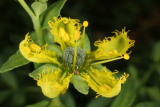


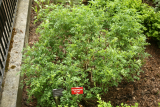
.JPG)
.JPG)
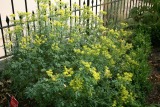
.JPG)
 and bee.JPG)
 and bee.JPG)
 and bee.JPG)
 and bee.JPG)
 and bee.JPG)
.JPG)
